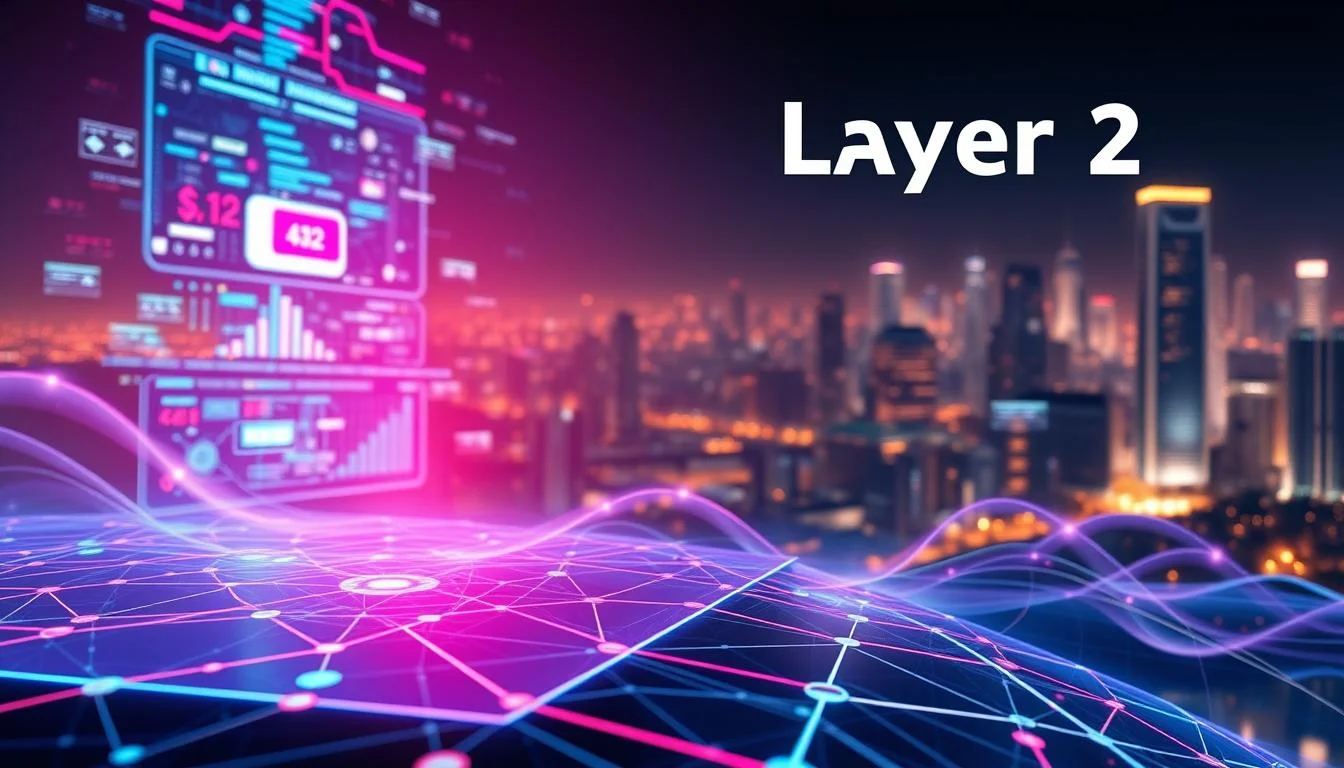Layer 2 Crypto Projects. Have you ever wondered how blockchain networks can handle millions of transactions without slowing down or becoming too expensive? The answer lies in Layer 2 solutions. These innovative projects are transforming the way blockchains operate, making them faster, cheaper, and more efficient.
As the demand for decentralized applications grows, networks like Ethereum face challenges such as high fees and congestion. This is where Layer 2 crypto projects step in. They act as secondary frameworks built on top of existing blockchains, enhancing their capabilities without compromising security.
Leading examples like Polygon zkEVM, Arbitrum, and OP Mainnet are already making waves in the market. These solutions not only reduce transaction costs but also improve speed, making blockchain technology more accessible to everyone. Whether you’re a developer or a user, understanding these projects is key to navigating the future of decentralized systems.
Key Takeaways
- Layer 2 solutions enhance blockchain scalability and efficiency.
- They reduce transaction costs and improve network speed.
- Projects like Polygon zkEVM and Arbitrum are leading the way.
- These solutions integrate seamlessly with Ethereum and other blockchains.
- They address challenges like high fees and network congestion.
Understanding Layer 2 Crypto: Revolutionizing Blockchain Scalability
Blockchain networks face a trilemma: security, decentralization, and scalability. While Layer 1 chains like Ethereum and Bitcoin excel in security and decentralization, they struggle with scalability. This is where Layer 2 solutions come into play, offering a way to enhance transaction speed and reduce costs without compromising the core principles of blockchain technology.
100X Coint? – Your Ticket to Becoming a Crypto Millionaire! Click here to learn more
What Are Layer 2 Solutions?
Layer 2 solutions are secondary frameworks built on top of existing blockchains. They process transactions off the main chain, reducing congestion and improving efficiency. Think of it like adding an extra machine to a biscuit factory. While the main machine handles the core production, the additional machine speeds up the process, ensuring more biscuits are made in less time.
Examples of Layer 2 networks include Bitcoin’s Lightning Network and Ethereum’s Raiden Network. These solutions enable faster and cheaper transactions by moving them off the main chain. They maintain decentralization while addressing the scalability issues of Layer 1 blockchains.
The Benefits of Implementing Layer 2 Networks
Layer 2 networks offer several advantages:
- Reduced Transaction Fees: By processing transactions off-chain, Layer 2 solutions significantly lower costs.
- Increased Throughput: These networks can handle thousands of transactions per second, making them ideal for high-demand applications.
- Enhanced Security: Layer 2 solutions inherit the security of the underlying blockchain, ensuring trust and reliability.
For instance, Optimism and StarkNet are leading projects that have revolutionized Ethereum’s scalability. They reduce gas fees and improve transaction speed, making decentralized applications more accessible to users.
“Layer 2 solutions are the key to unlocking blockchain’s full potential, offering scalability without sacrificing security or decentralization.”
Here’s a quick comparison of Layer 1 and Layer 2 networks:
| Feature | Layer 1 | Layer 2 |
|---|---|---|
| Transaction Speed | Slow | Fast |
| Cost | High | Low |
| Scalability | Limited | High |
By addressing the scalability trilemma, Layer 2 solutions are paving the way for the next generation of blockchain technology. Whether you’re a developer or a user, understanding these networks is essential for navigating the future of decentralized systems.
Key layer 2 crypto Projects Transforming Blockchain Transactions
The blockchain space is evolving rapidly, with innovative projects addressing scalability challenges head-on. These solutions are designed to enhance transaction speed and reduce costs, making decentralized systems more efficient and accessible. Below, we explore some of the most impactful projects and their contributions to the market.

Notable Projects and Their Innovations
Projects like Metis and ImmutableX are leading the charge in improving blockchain efficiency. Metis focuses on decentralized autonomous companies (DACs), offering a framework for faster and cheaper transactions. ImmutableX, on the other hand, specializes in NFTs, providing a seamless experience for creators and collectors alike.
Celer Network and Cartesi are also making waves. Celer Network enhances cross-chain interoperability, while Cartesi brings traditional software development tools to blockchain, simplifying dApp creation. These projects showcase the diversity of scaling solutions available today.
How These Projects Enhance Transaction Speed and Lower Costs
One of the standout features of these projects is their ability to process transactions off the main chain. For example, Arbitrum uses Optimistic Rollups to bundle multiple transactions into one, reducing fees and increasing throughput. Similarly, StarkNet leverages Zero-Knowledge Rollups to ensure privacy and efficiency.
These innovations not only improve speed but also lower costs significantly. By moving transactions off the main chain, projects like Scroll and Manta ensure that users can interact with decentralized applications without worrying about high fees.
“The integration of Layer 2 solutions is a game-changer for blockchain, offering scalability without compromising security or decentralization.”
Here’s a quick look at how these projects compare:
| Project | Innovation | Key Benefit |
|---|---|---|
| Metis | DAC Framework | Cost Efficiency |
| ImmutableX | NFT Specialization | Seamless Experience |
| Celer Network | Cross-Chain Interoperability | Enhanced Connectivity |
| Cartesi | Traditional Software Tools | Simplified dApp Development |
These projects are not just solving current issues but are also shaping the future of decentralized finance. By addressing scalability, they are paving the way for broader adoption and more innovative applications.
Exploring Diverse Layer 2 Solutions and Real-Life Use Cases
Scalability remains one of the biggest hurdles for blockchain adoption, but innovative solutions are changing the game. From state channels to rollups, these technologies are transforming how transactions are processed, making them faster and more cost-effective. Let’s dive into the details and explore real-life examples that showcase their impact.
State Channels and Their Practical Applications
State channels are off-chain solutions that allow participants to conduct multiple transactions without recording each one on the main chain. Think of it as a private conversation between two parties, where only the final outcome is shared publicly. This approach significantly reduces congestion and fees.
A prime example is Bitcoin’s Lightning Network. It enables instant micropayments by opening a channel between users. Once the channel is closed, the final state is recorded on the Bitcoin blockchain. This method has proven effective for everyday transactions, from buying coffee to tipping content creators.

Rollups: Optimistic vs. Zero-Knowledge for Scalability
Rollups bundle multiple transactions into a single one, processing them off-chain before submitting the data to the main chain. There are two main types: Optimistic Rollups and Zero-Knowledge Rollups.
Optimistic Rollups assume transactions are valid unless proven otherwise. They are cost-effective but require a challenge period to resolve disputes. Projects like Arbitrum use this method to enhance Ethereum’s scalability.
Zero-Knowledge Rollups, on the other hand, use cryptographic proofs to validate transactions instantly. They offer higher security and privacy, as seen in StarkNet and zkSync. Both methods have their pros and cons, but they share the same goal: improving transaction efficiency.
Case Studies: Bitcoin Lightning Network and Starkware
The Bitcoin Lightning Network is a real-world success story. It has enabled millions of transactions, reducing fees and increasing speed. This solution is particularly useful for small, frequent payments, making Bitcoin more practical for everyday use.
On the Ethereum side, Starkware has developed products like StarkNet and StarkEx. These leverage Zero-Knowledge Rollups to handle complex computations off-chain, reducing gas fees and improving scalability. Starkware’s Cairo programming language further simplifies development, making it easier to build decentralized applications.
“State channels and rollups are revolutionizing blockchain scalability, offering faster and cheaper transactions without compromising security.”
Here’s a comparison of state channels and rollups:
| Feature | State Channels | Rollups |
|---|---|---|
| Transaction Speed | Instant | Fast |
| Cost | Low | Low |
| Scalability | High for microtransactions | High for complex transactions |
These solutions are not just theoretical; they are already making a significant impact on the market. By reducing fees and improving speed, they are paving the way for broader adoption of blockchain technology.
Conclusion
Layer 2 solutions are reshaping the blockchain landscape by addressing scalability challenges head-on. These networks reduce transaction fees and increase speed, making decentralized systems more efficient. Projects like Ethereum, zkSync, and Manta are leading the charge, offering innovative approaches to enhance blockchain performance.
By complementing Layer 1 blockchains, these solutions ensure faster and cheaper transactions without compromising security. Real-life examples like Bitcoin’s Lightning Network showcase their practical impact. Rollups and state channels further highlight the technical advancements driving this evolution.
As the market cap of these projects grows, their influence on the blockchain space becomes undeniable. Stay informed about emerging technologies like Loopring LRC and Mantle to keep up with this rapidly evolving field. Explore further to understand how these innovations are shaping the future of decentralized systems.






